Why you can trust Tom's Hardware
Gaming at 4K on the RX 7900 GRE can be a bit hit and miss. For most rasterization games, it's totally within reach — and games that support FSR 2/3 upscaling can usually break 60 fps. Dropping from ultra to high settings can also help. But ray tracing games at native 4K with maxed out settings often end up as a slide show and would mostly need Performance mode 4X upscaling to reach decent levels of performance.
AMD RX 7900 GRE 4K Overall Performance

Overall, the 7900 GRE takes a 3% lead over the RTX 4070 at 4K ultra. It's again the usual combination of faster rasterization performance and slower ray tracing results. The 7900 GRE also leads the 7800 XT by 8% overall, with a few games looking as though they're becoming more memory bandwidth constrained while other still look like they like the extra compute offered by the GRE.
Even without ray tracing enabled, some of the games fail to break 60 fps. Most newer games do support upscaling, but in some cases (like A Plague Tale: Requiem) it's only DLSS upscaling. You can enable AMD's driver-level RSR upscaling, but that's a lower quality spatial upscaling solution so it doesn't look as nice as FSR 2/3 temporal upscaling.
AFMF is also potentially worth a shot, or you can just go whole hog on AMD's enhancements and try HYPR-RX, but we've definitely encountered anomalies with certain games when taking that approach.
AMD RX 7900 GRE 4K Rasterization Performance
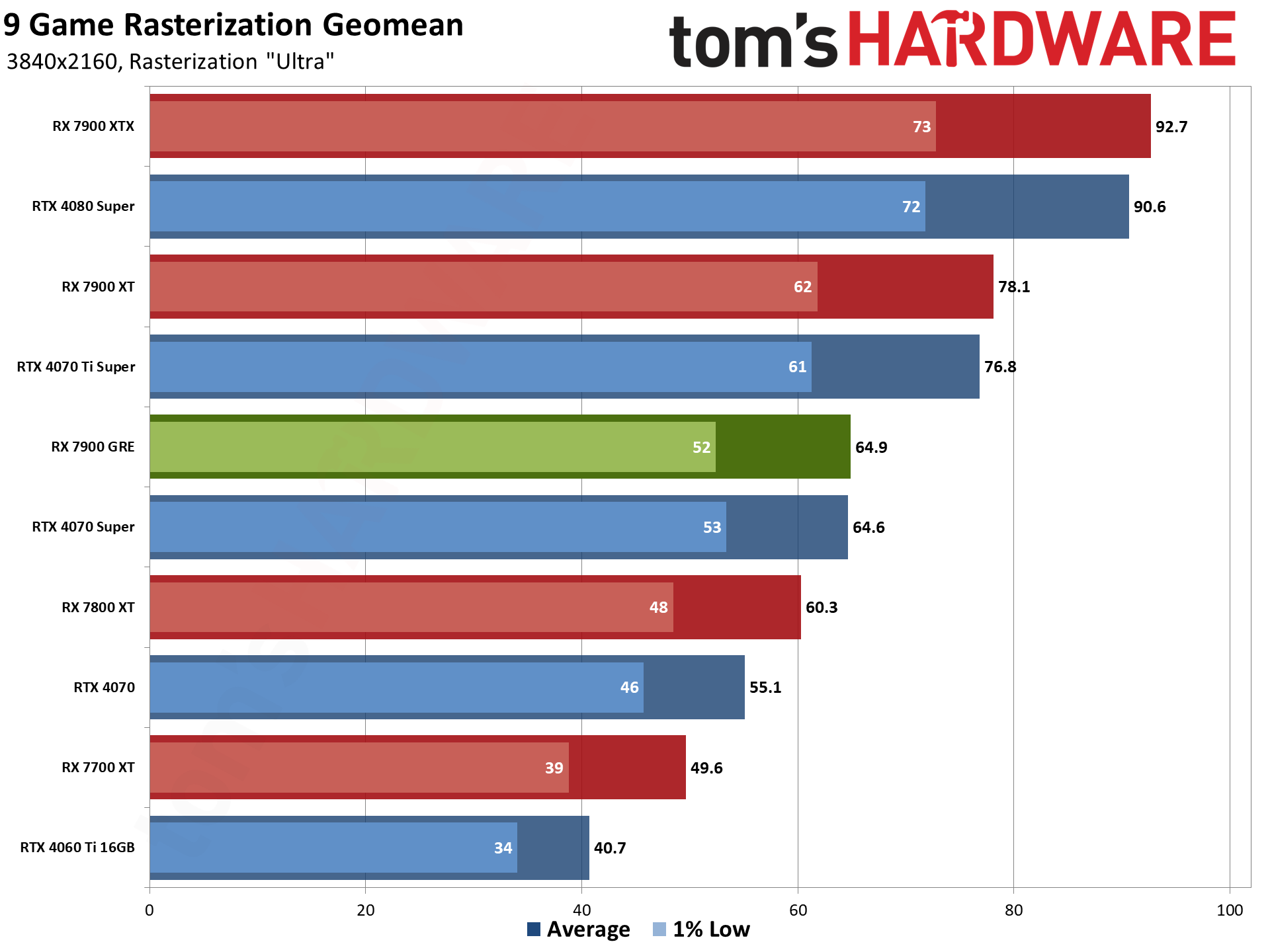
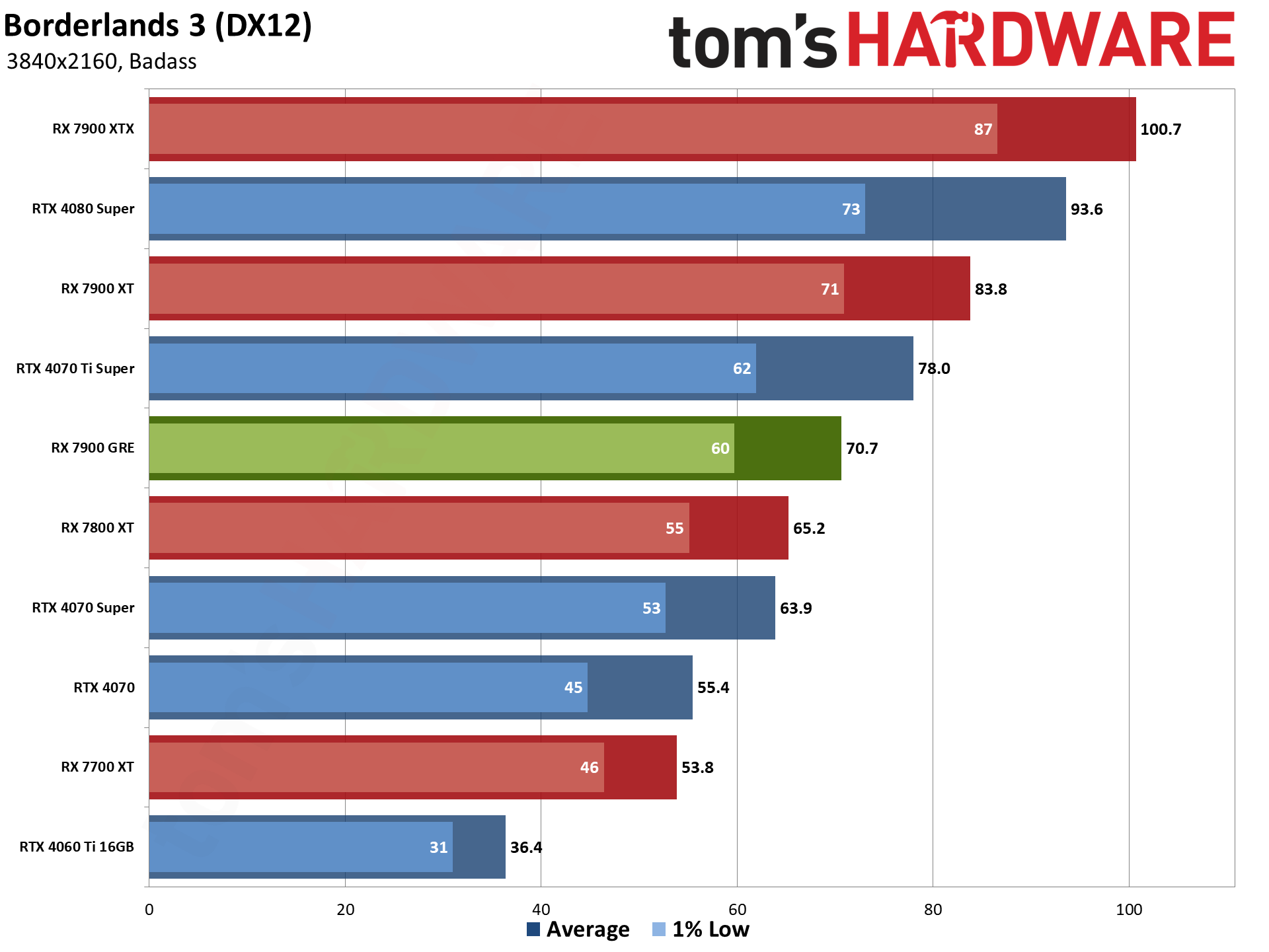
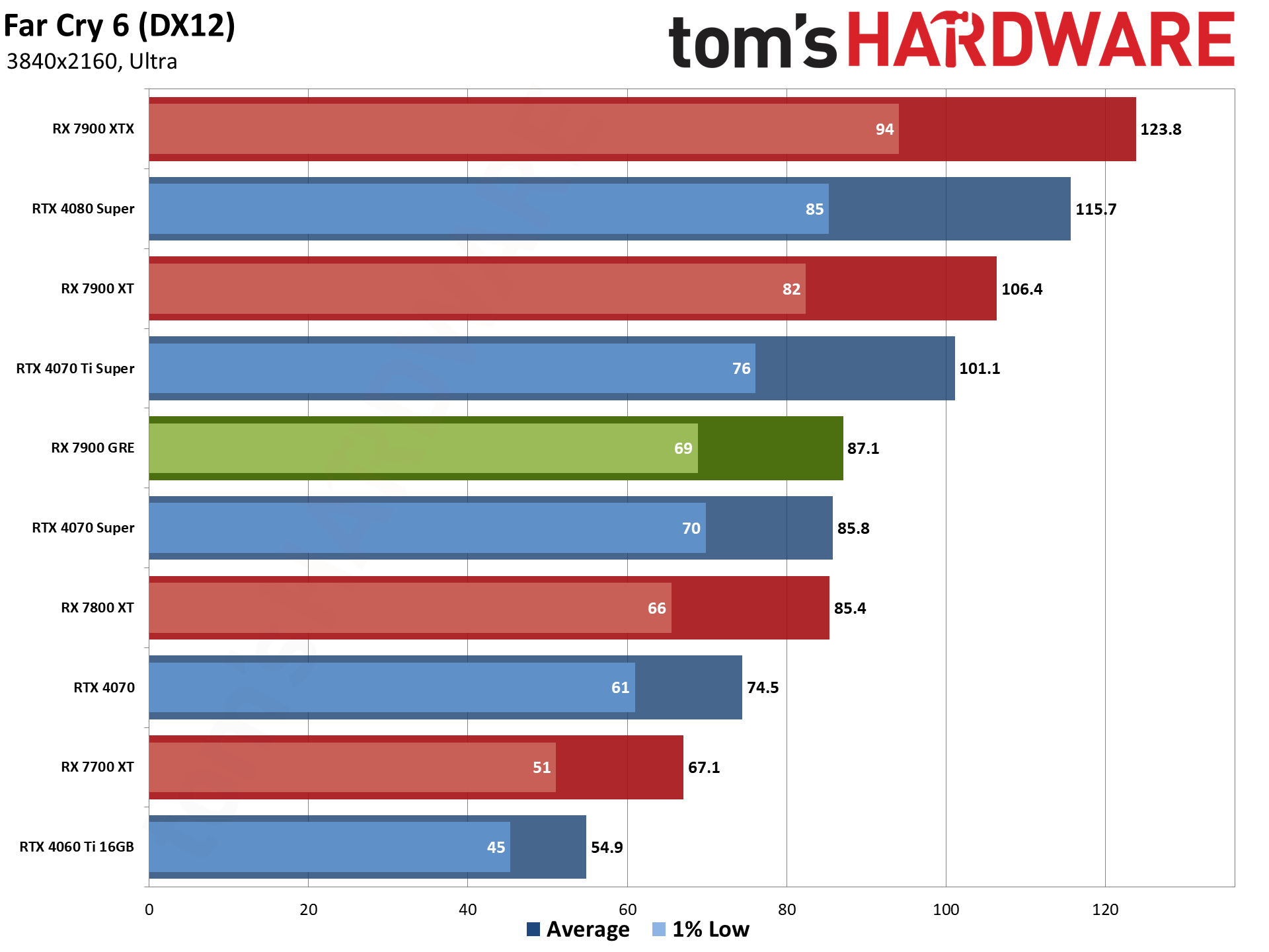
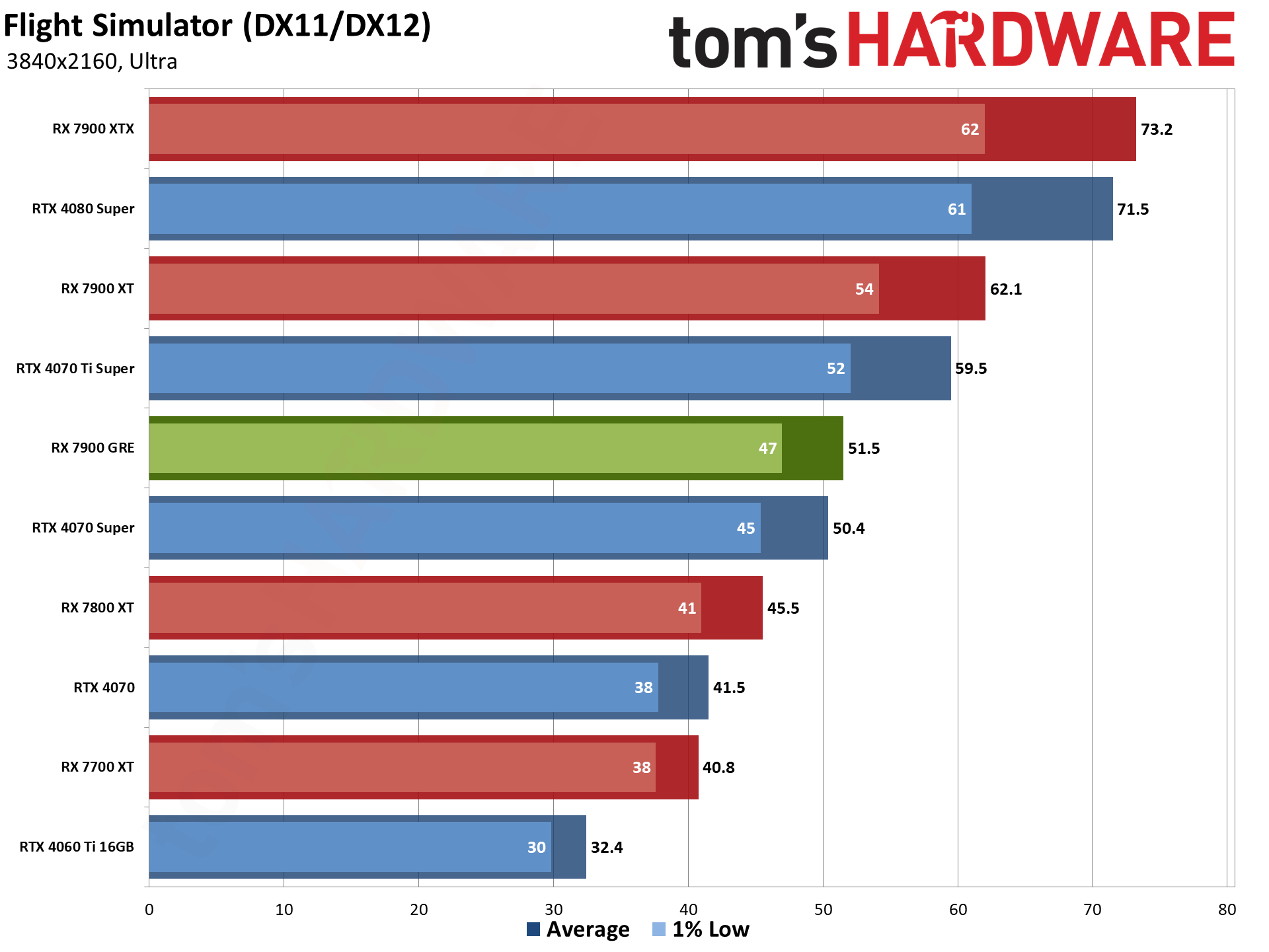
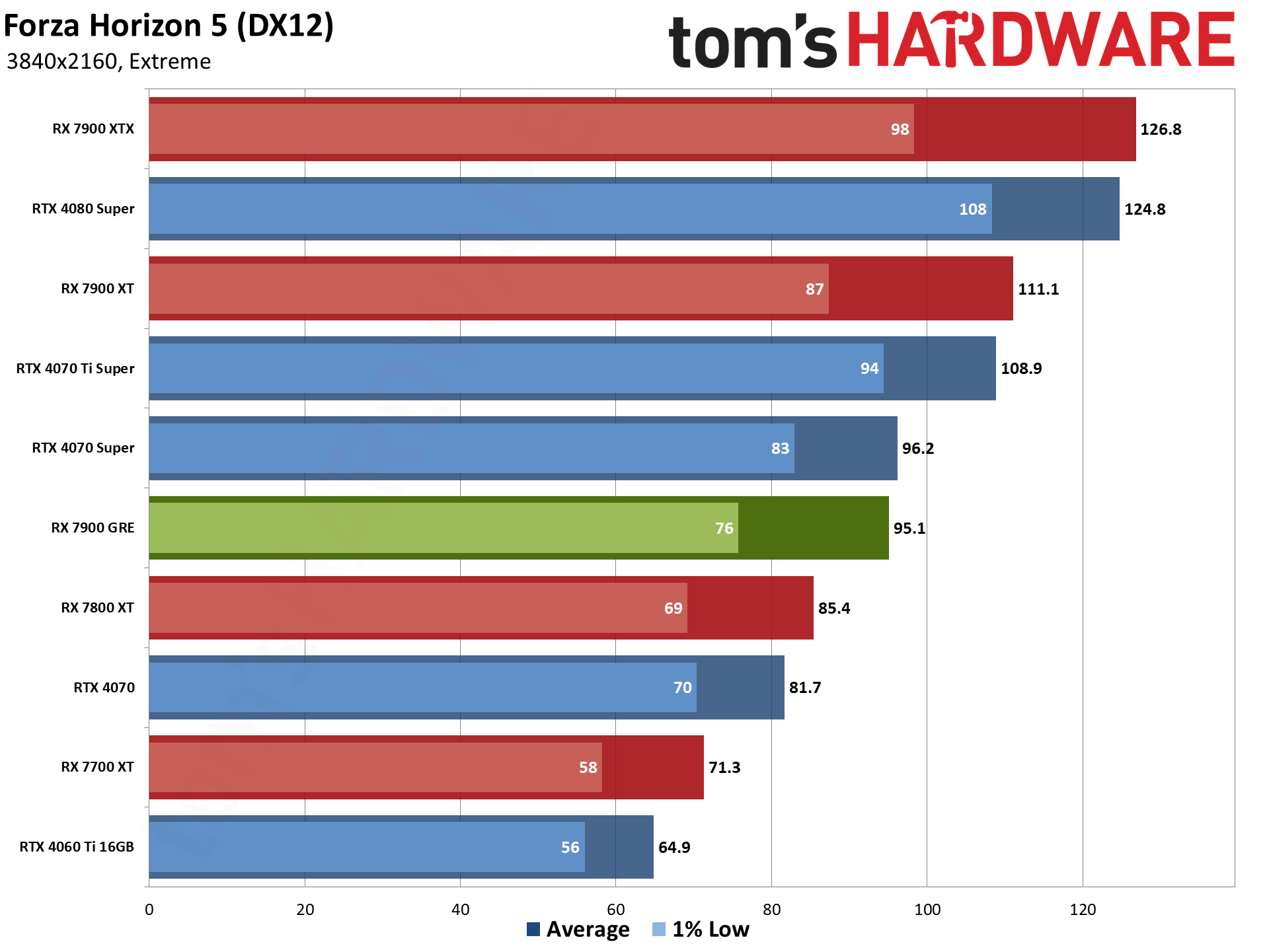
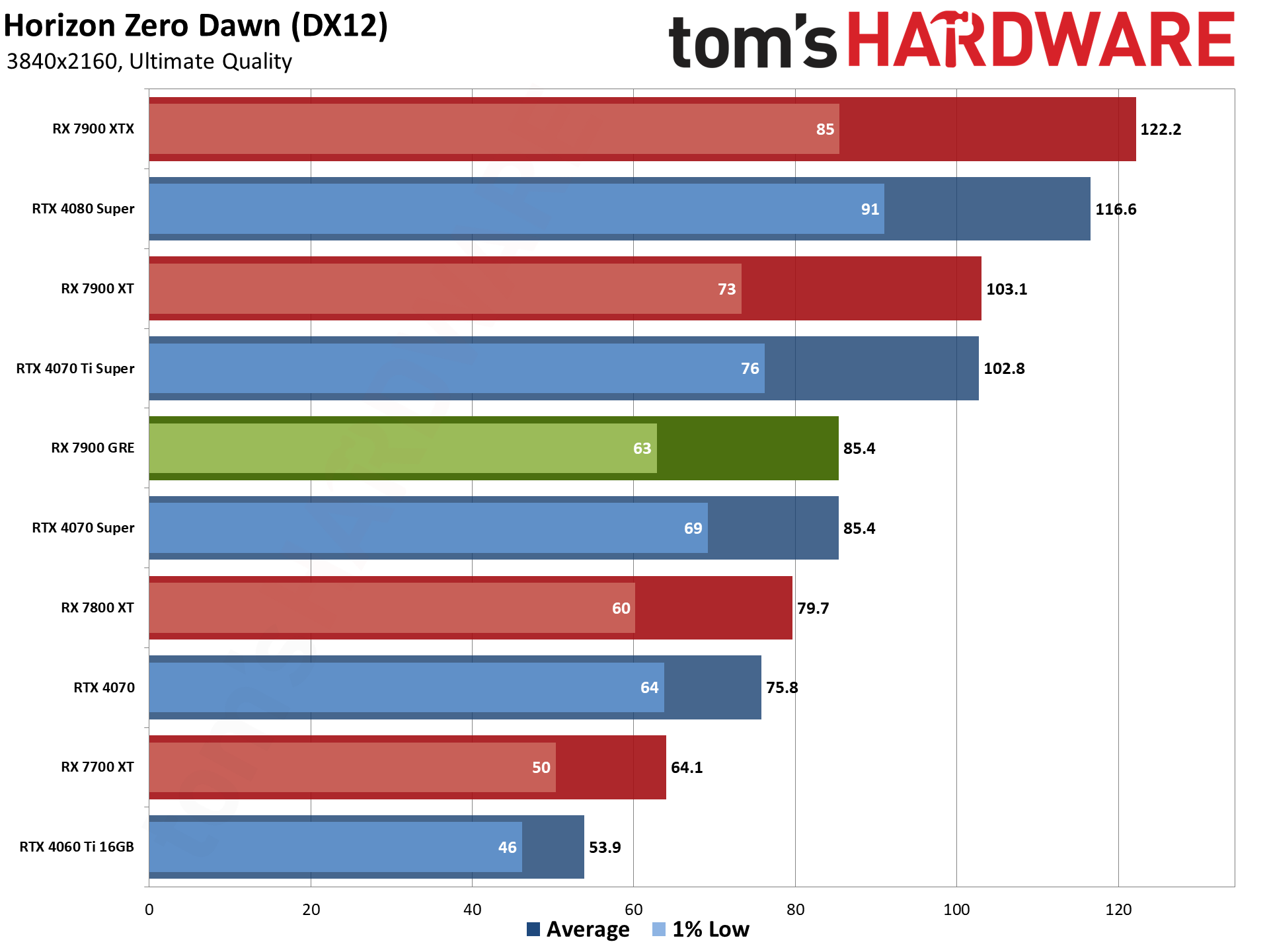
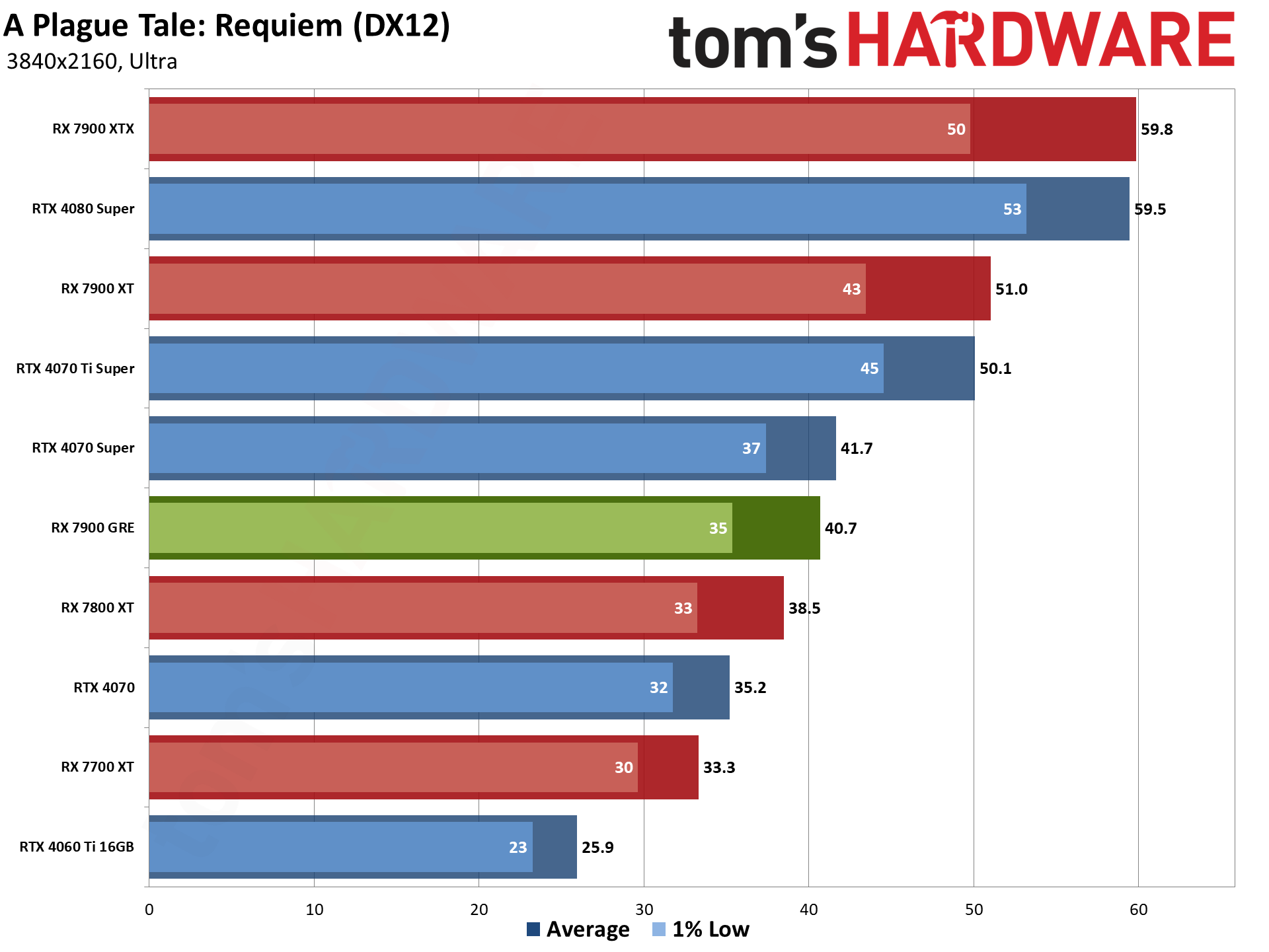
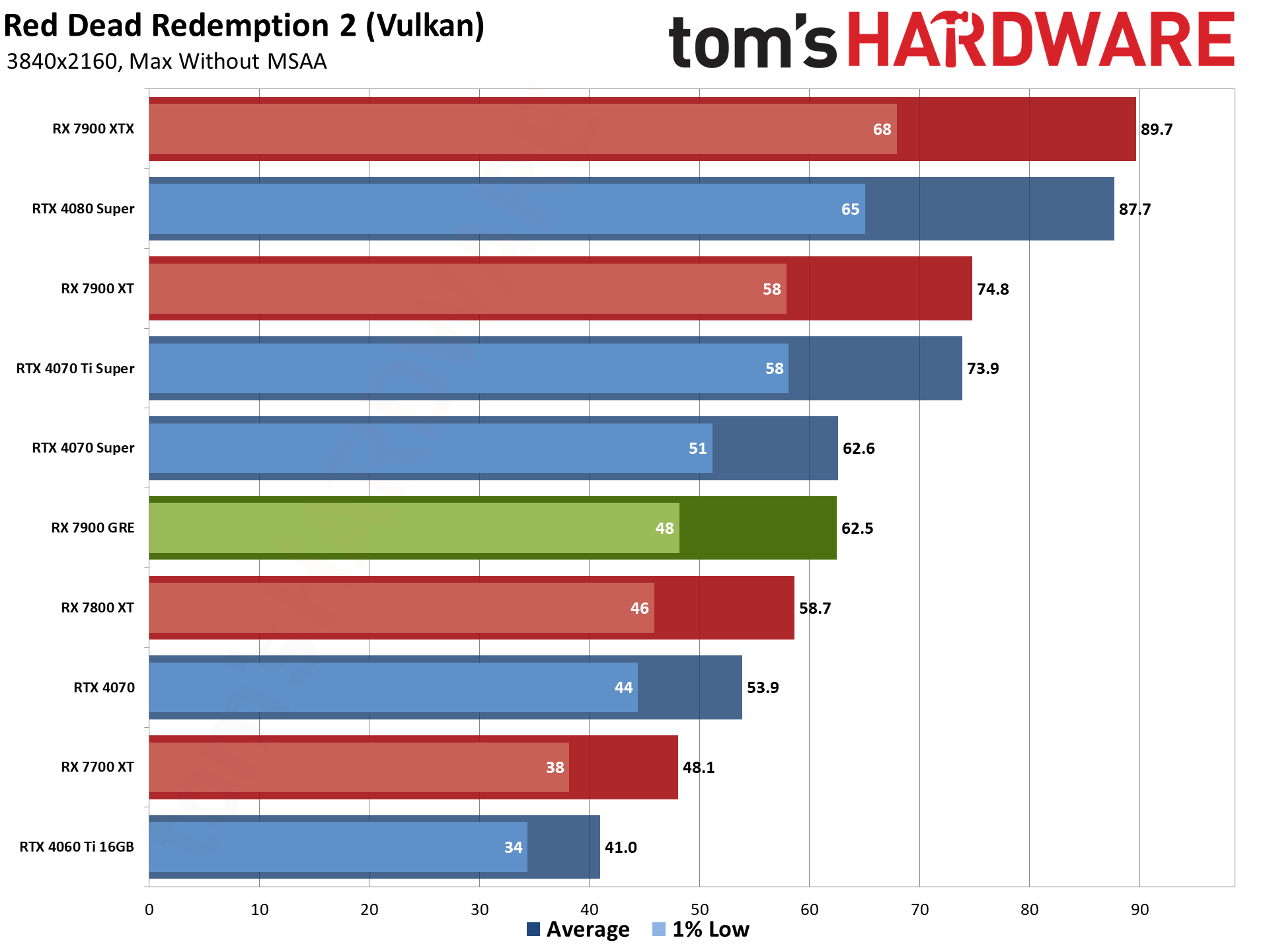
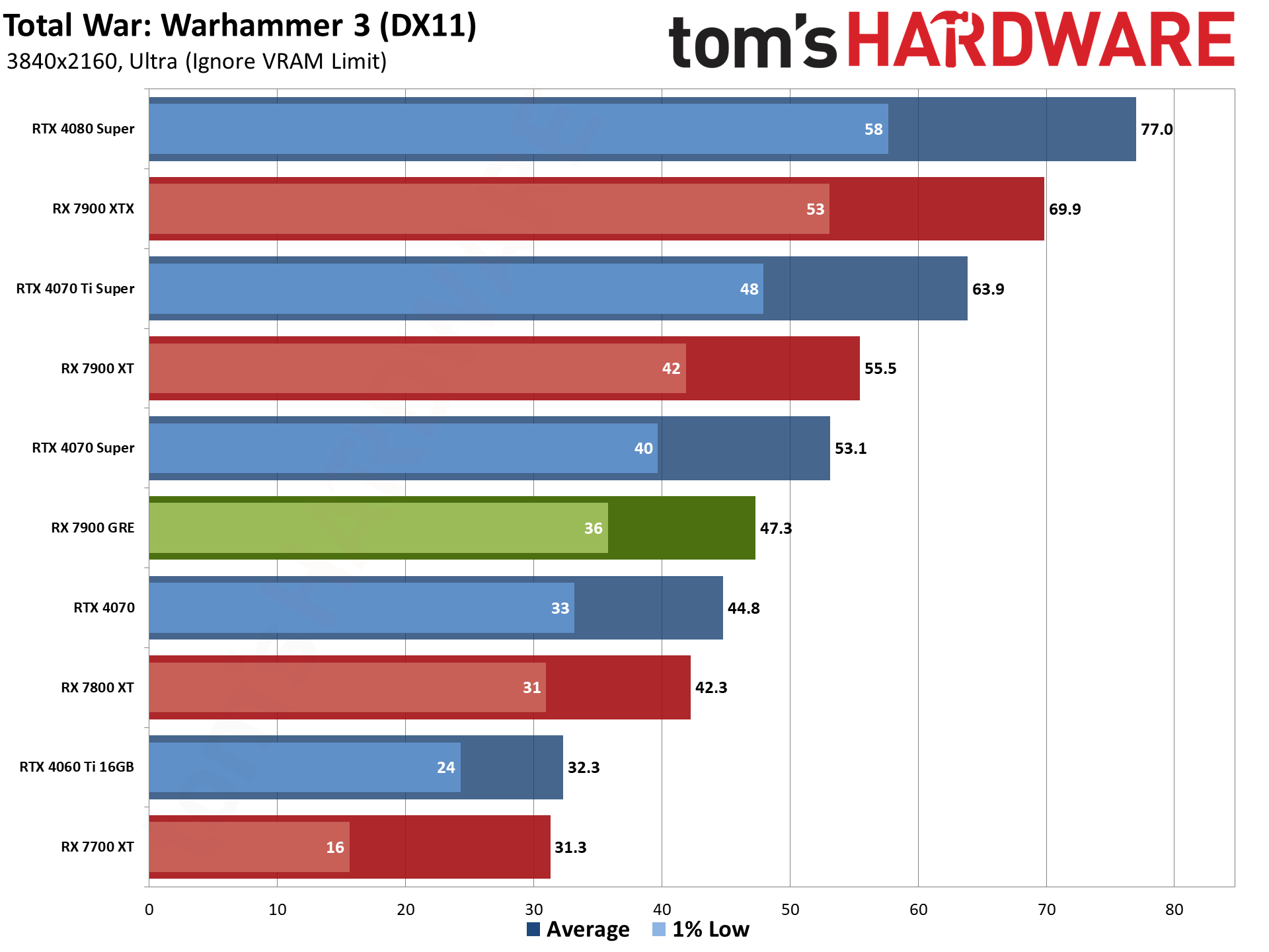
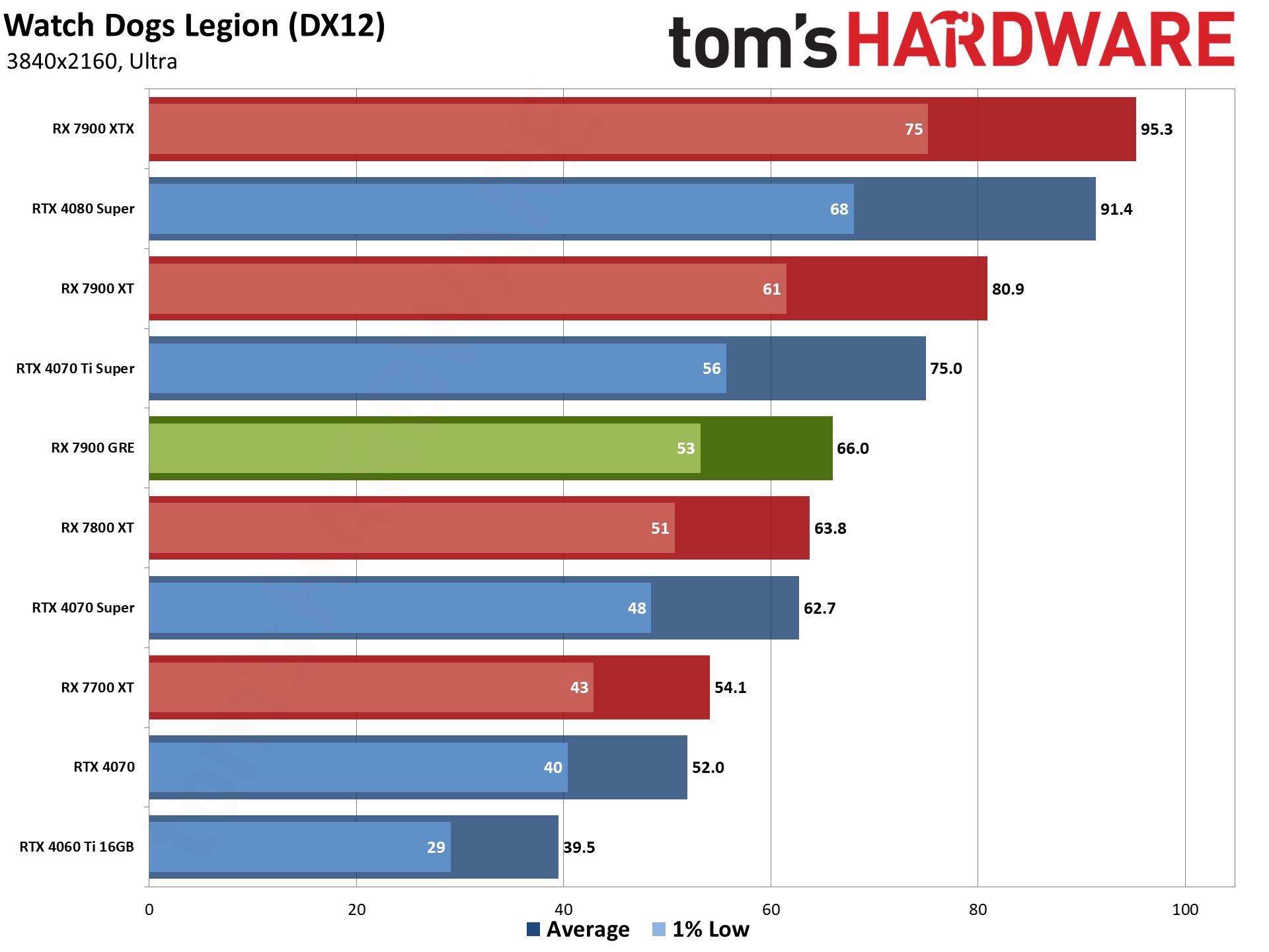
4K ultra gives the 7900 GRE its largest lead over the RTX 4070, with an 18% performance advantage. The 7900 GRE also averages 65 fps across our test suite while the 4070 sits at 55 fps, and looking at the individual games, there are three instances where the GRE can break 60 while the 4070 comes up short: Borderlands 3, Red Dead Redemption 2, and Watch Dogs Legion.
Compared to the 7800 XT, the GRE holds on to its 8% overall lead in rasterization performance, but a couple of games are almost tied: Far Cry 6 and Watch Dogs Legion. Both showed a bigger delta at 1440p, so they may be a bit more bandwidth hungry rather than wanting more compute.
AMD RX 7900 GRE 4K Ray Tracing Performance
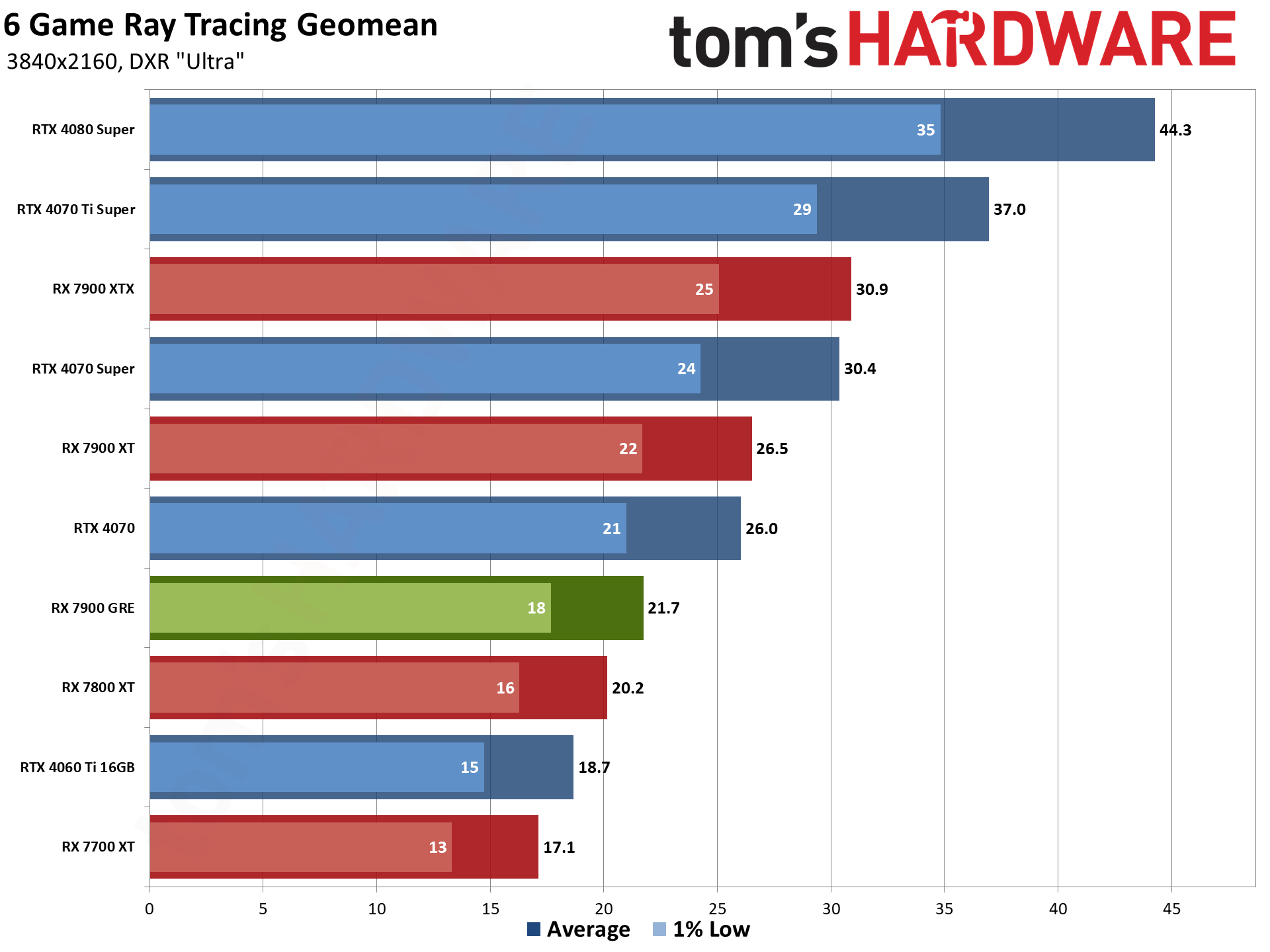
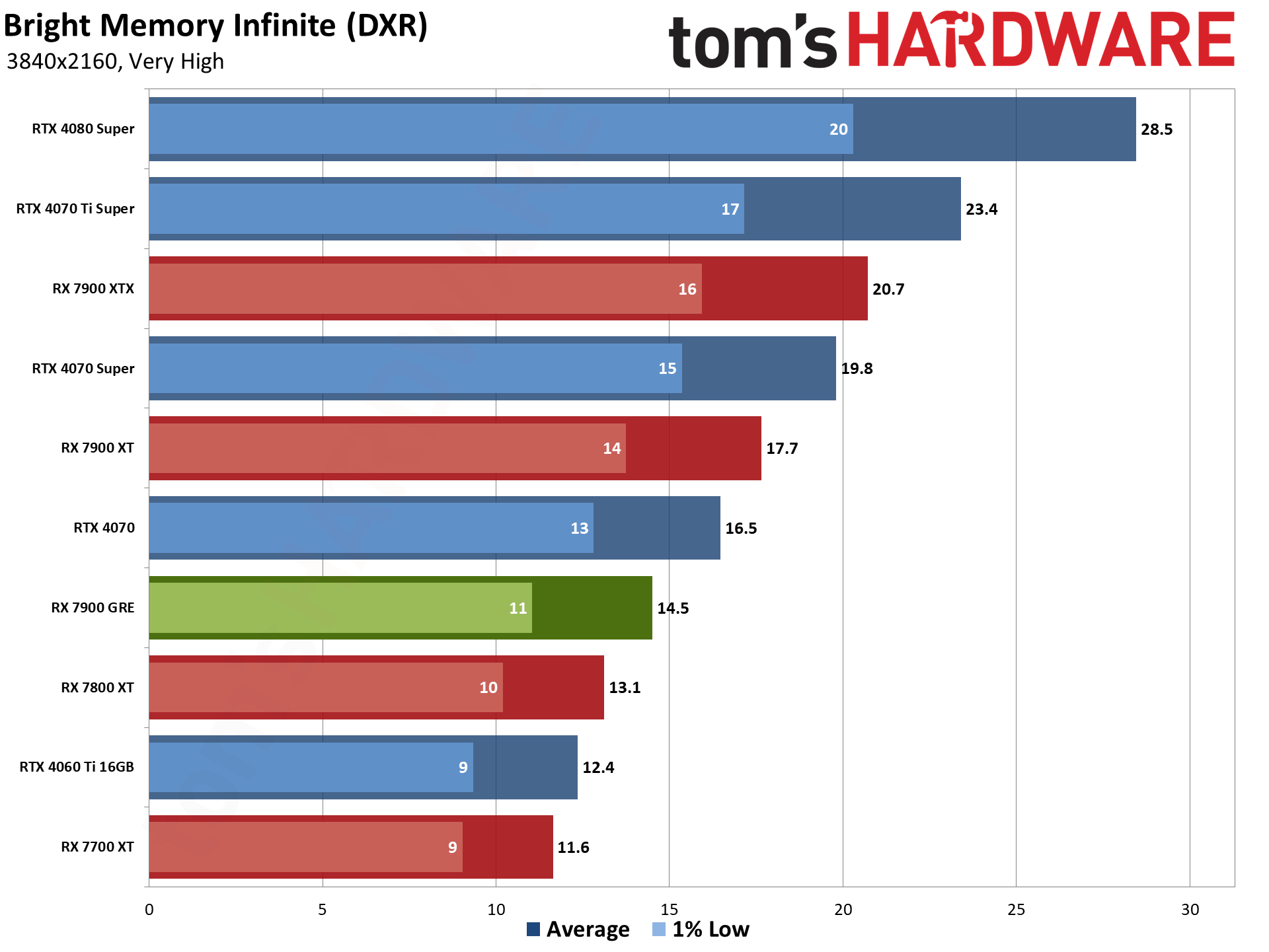
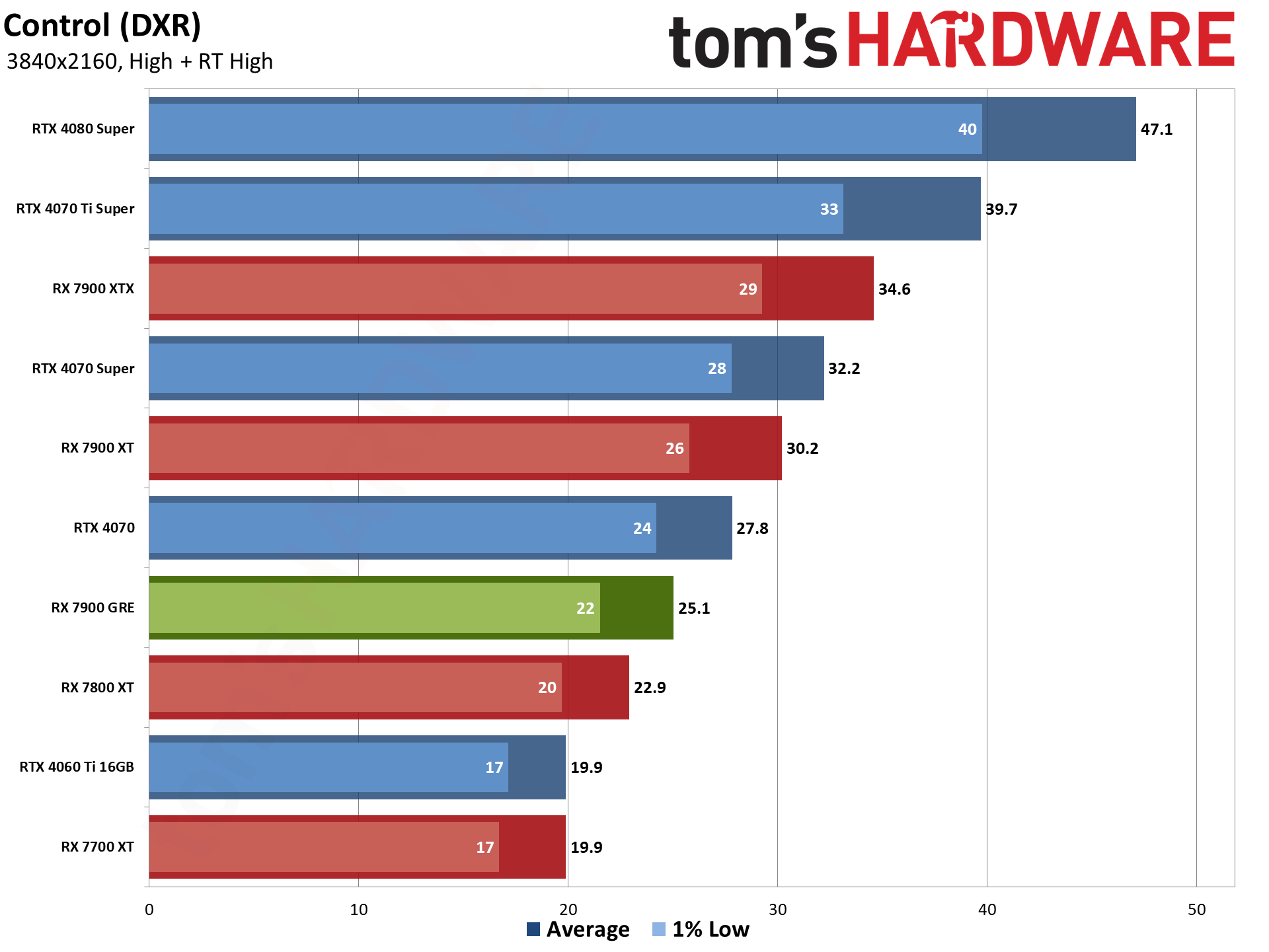
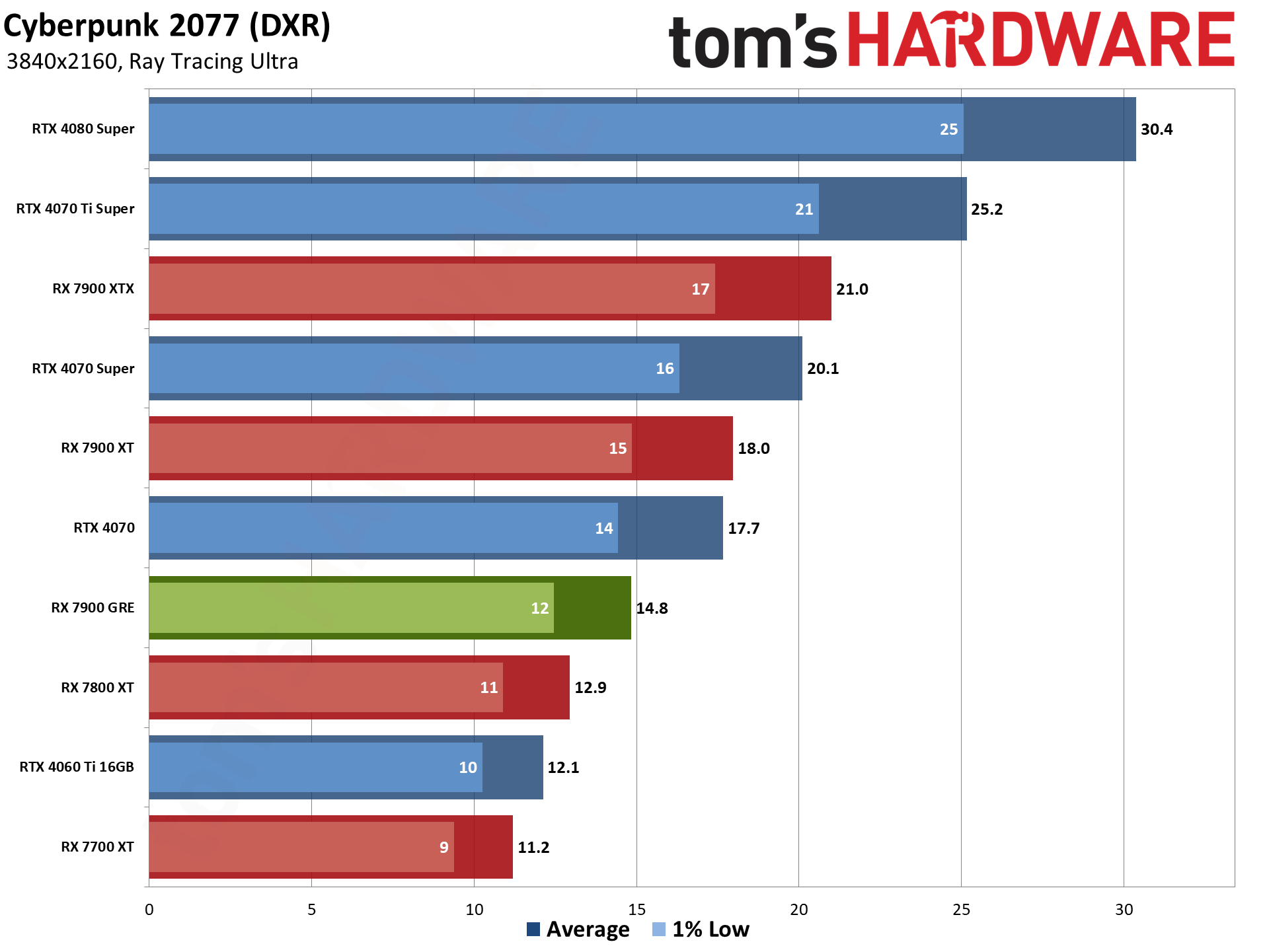
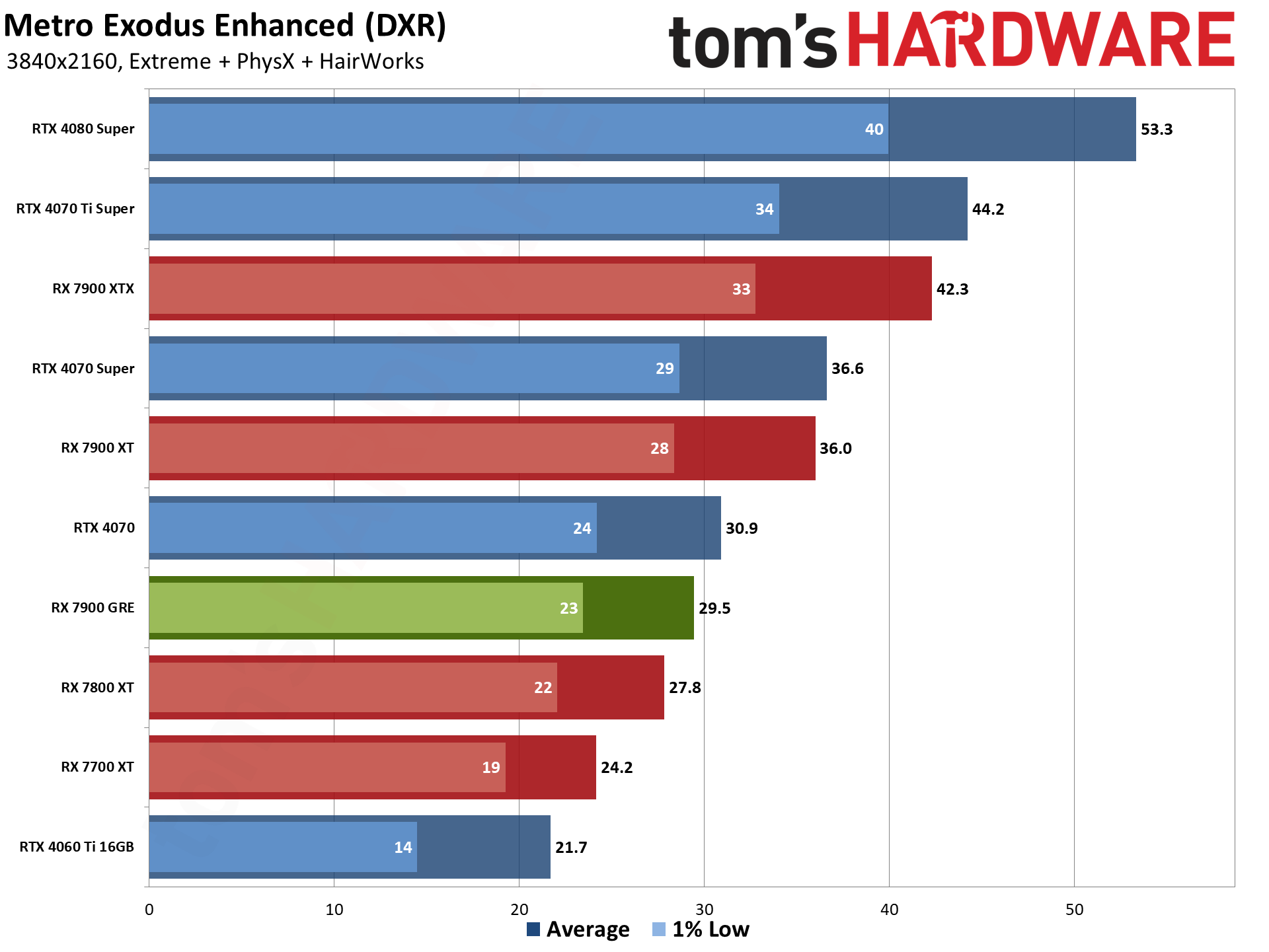
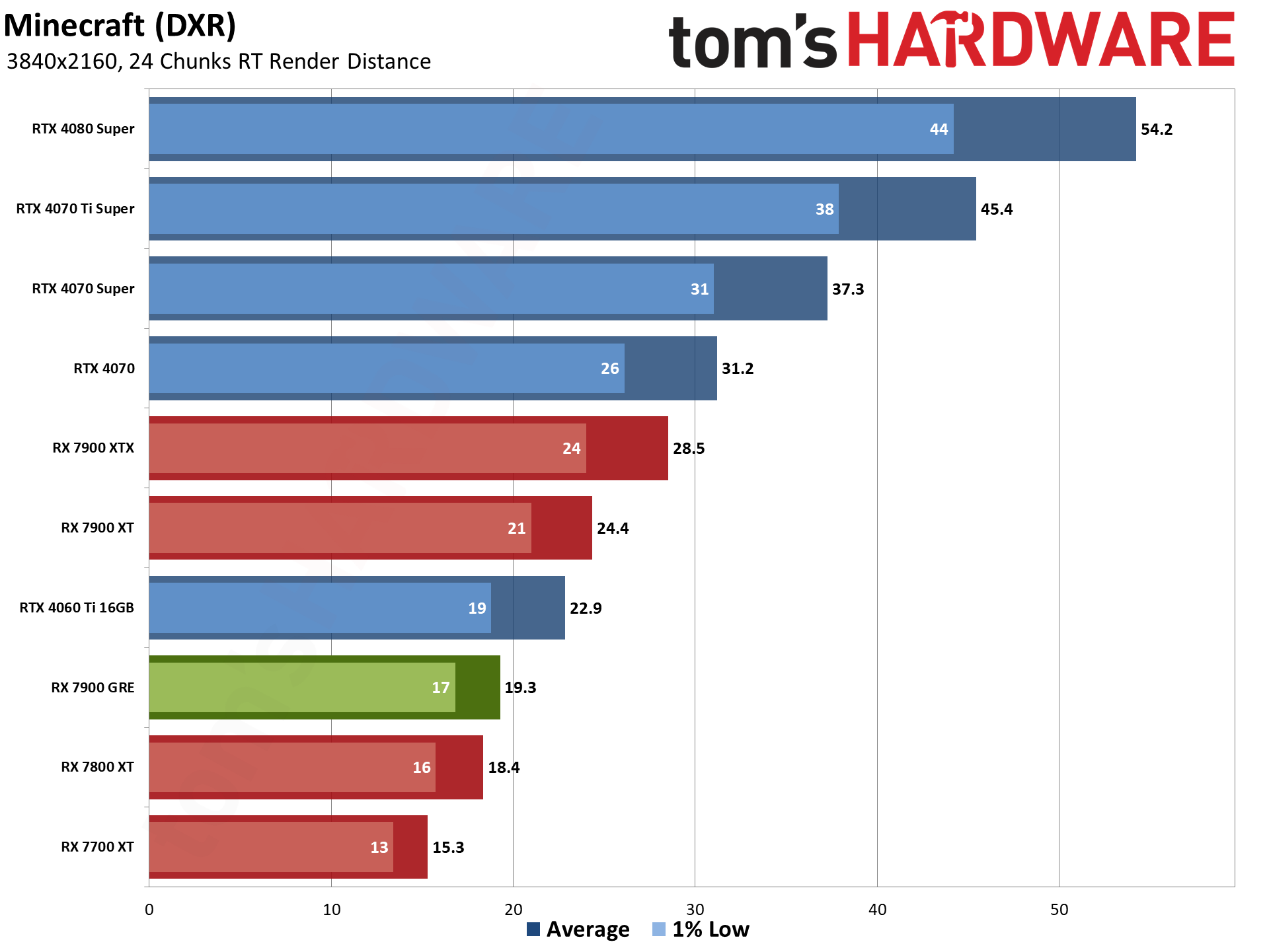
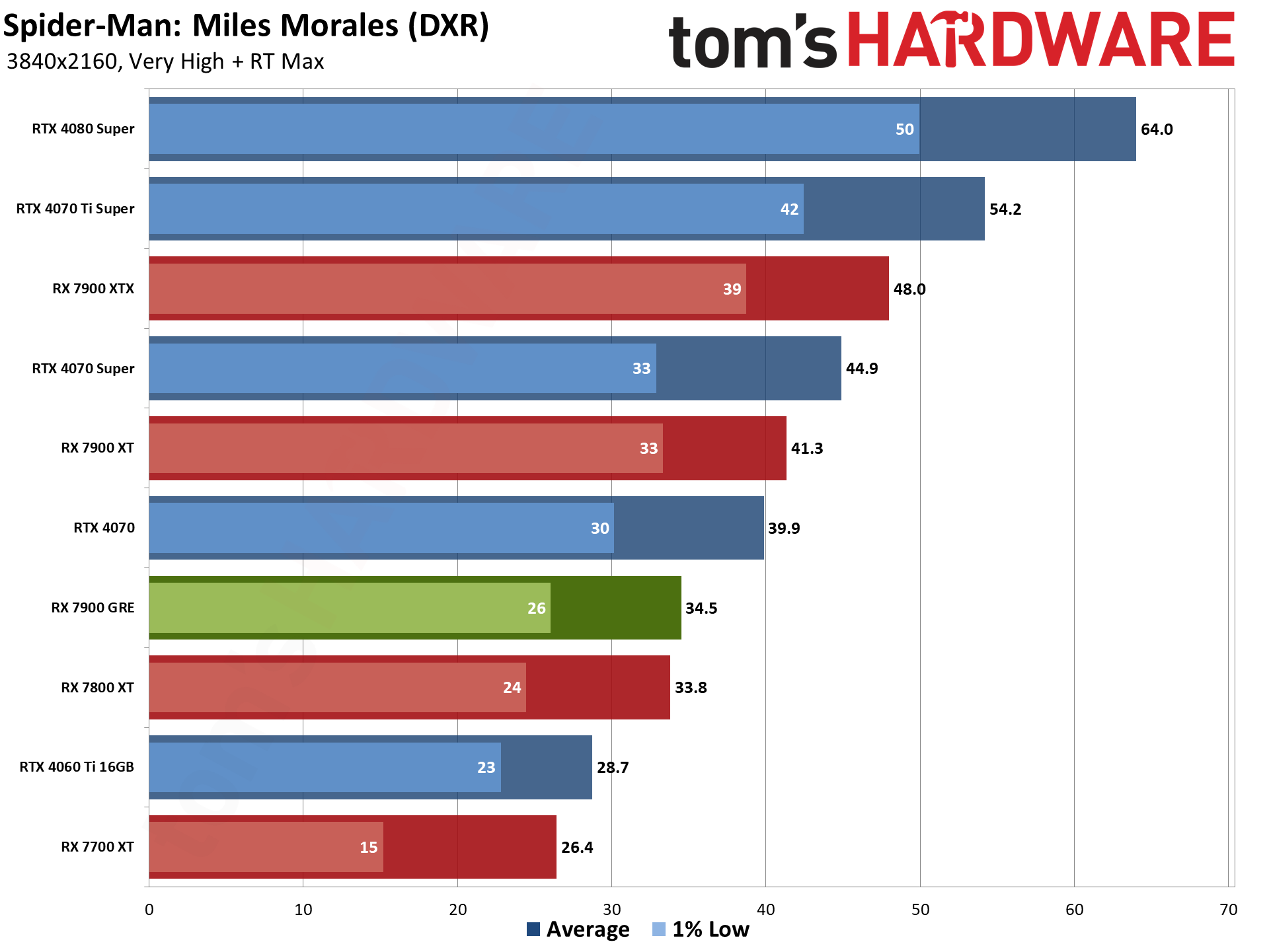
As hinted at above, 4K native rendering with ray tracing generally isn't going to fly on AMD GPUs, particularly not the third string 7900 GRE. Of the six games we tested with, only one (Spider-Man: Miles Morales) averages more than 30 fps, while Metro Exodus Enhanced comes in just shy of that mark.
Nvidia's RTX 4070 also fails to break 30 fps in several games, but it gets there in half of the titles we tested, and it's 20% faster than the GRE overall — without factoring in DLSS. So you give up a bit of "already playable" rasterization performance with Nvidia's card to get "maybe playable" ray tracing results, basically.
Looking at the 7800 XT, there are again several games where the gap between it and the 7900 GRE shrinks quite a bit. Spider-Man, Minecraft, and Metro are all practically a tie between the two cards (less than a 5% difference). If the 7900 GRE had 20 Gbps memory, we suspect it would have maintained 10% or higher performance leads.
AMD RX 7900 GRE 4K Bonus Games
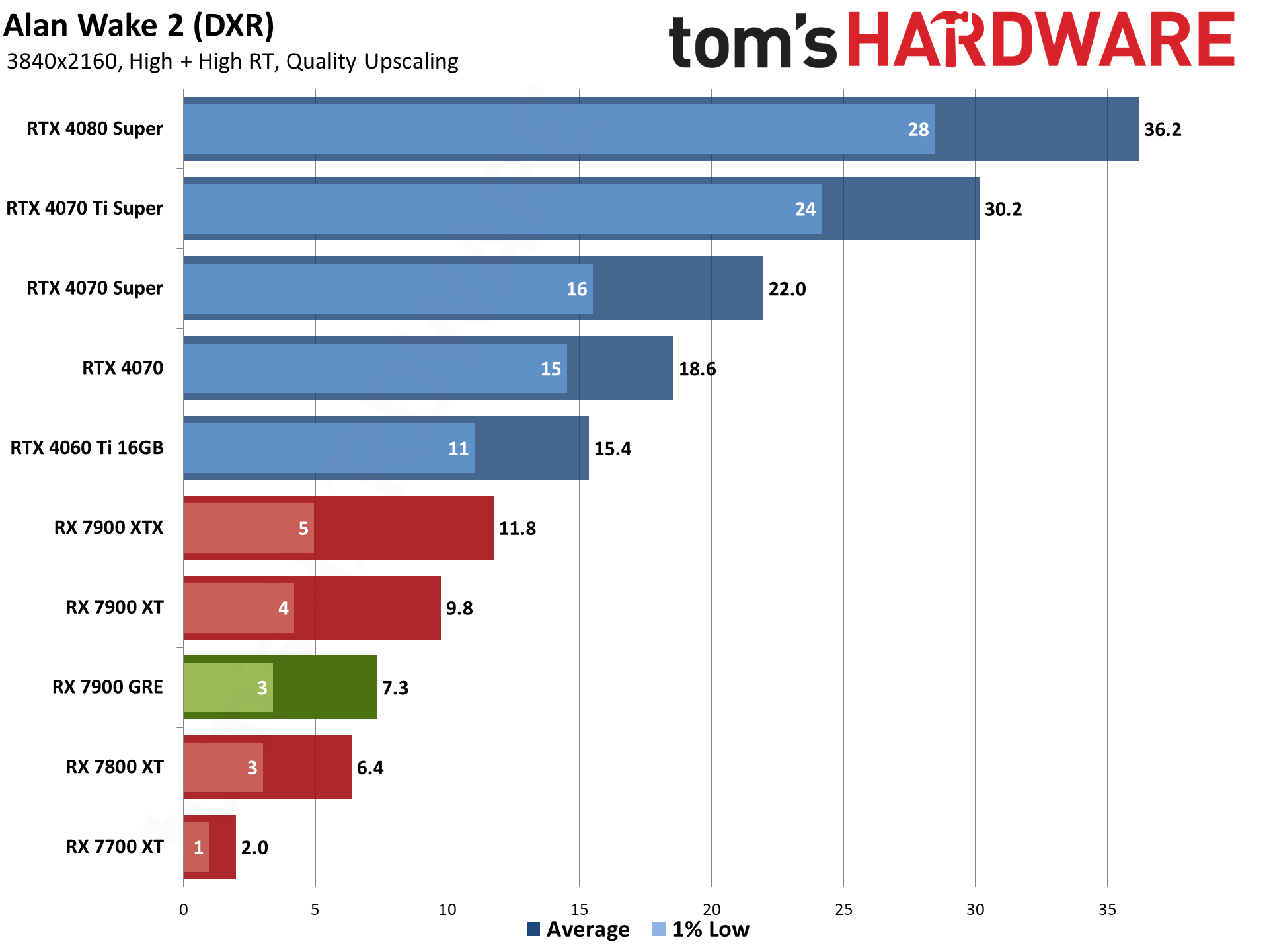
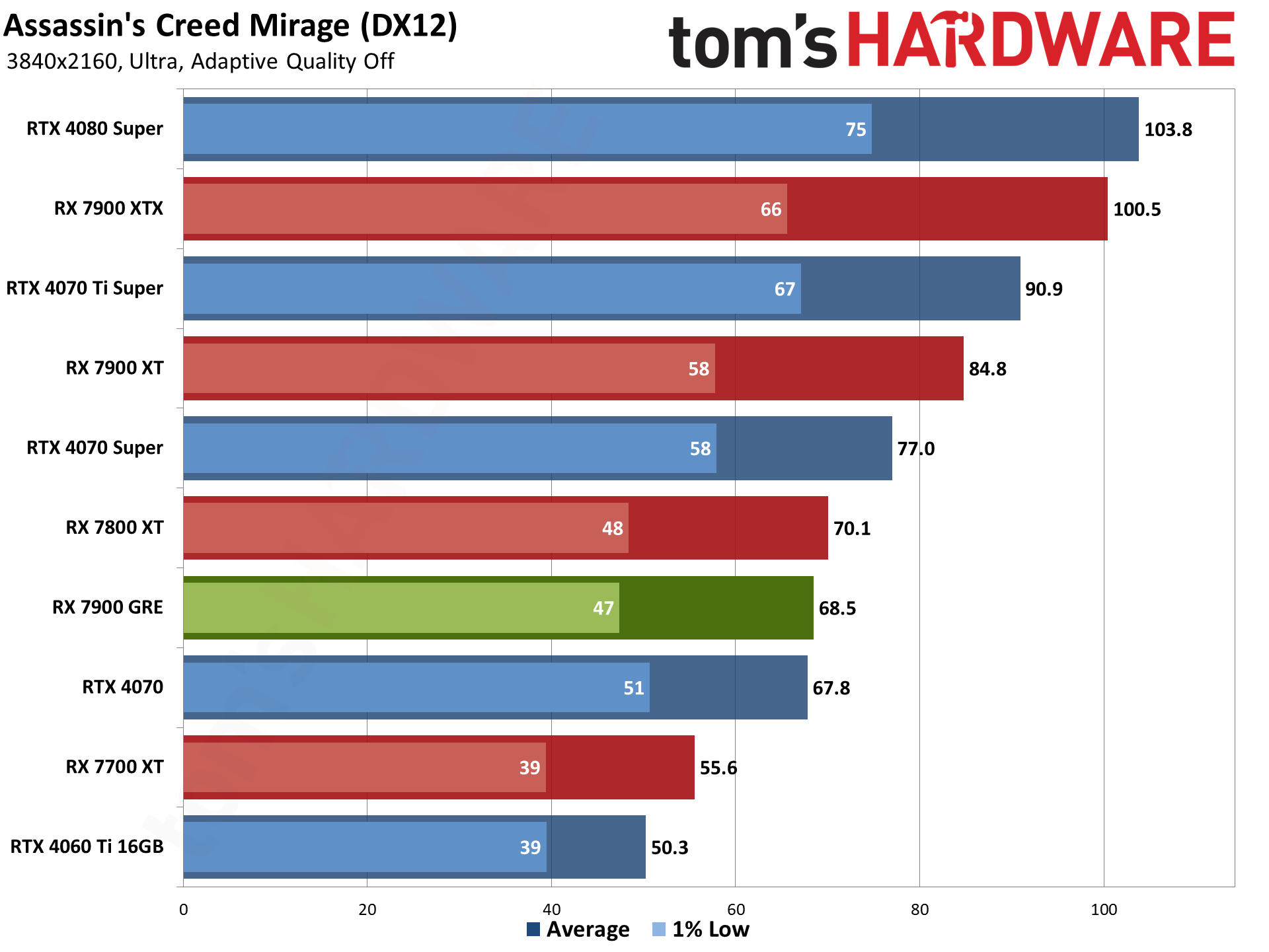
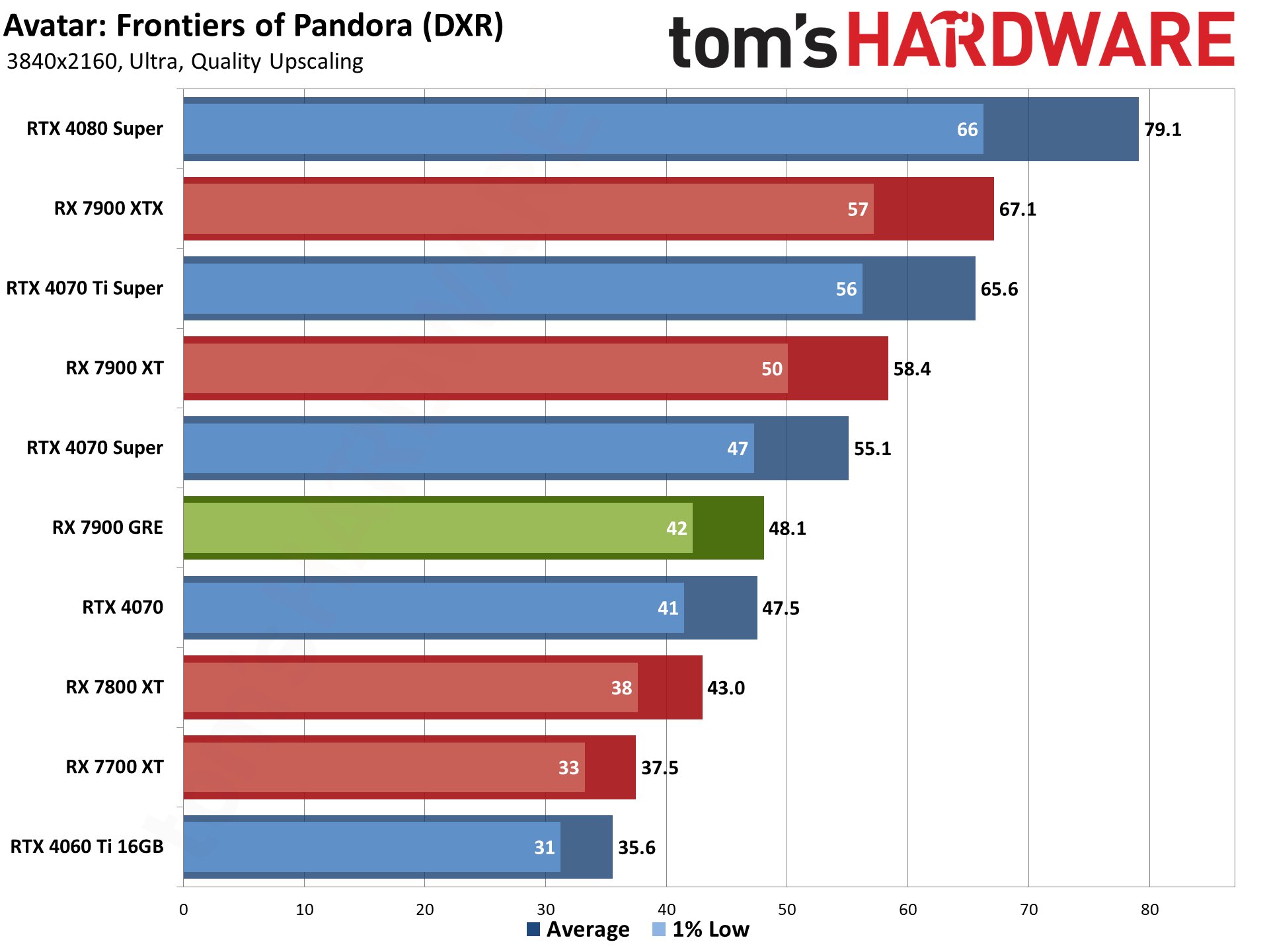
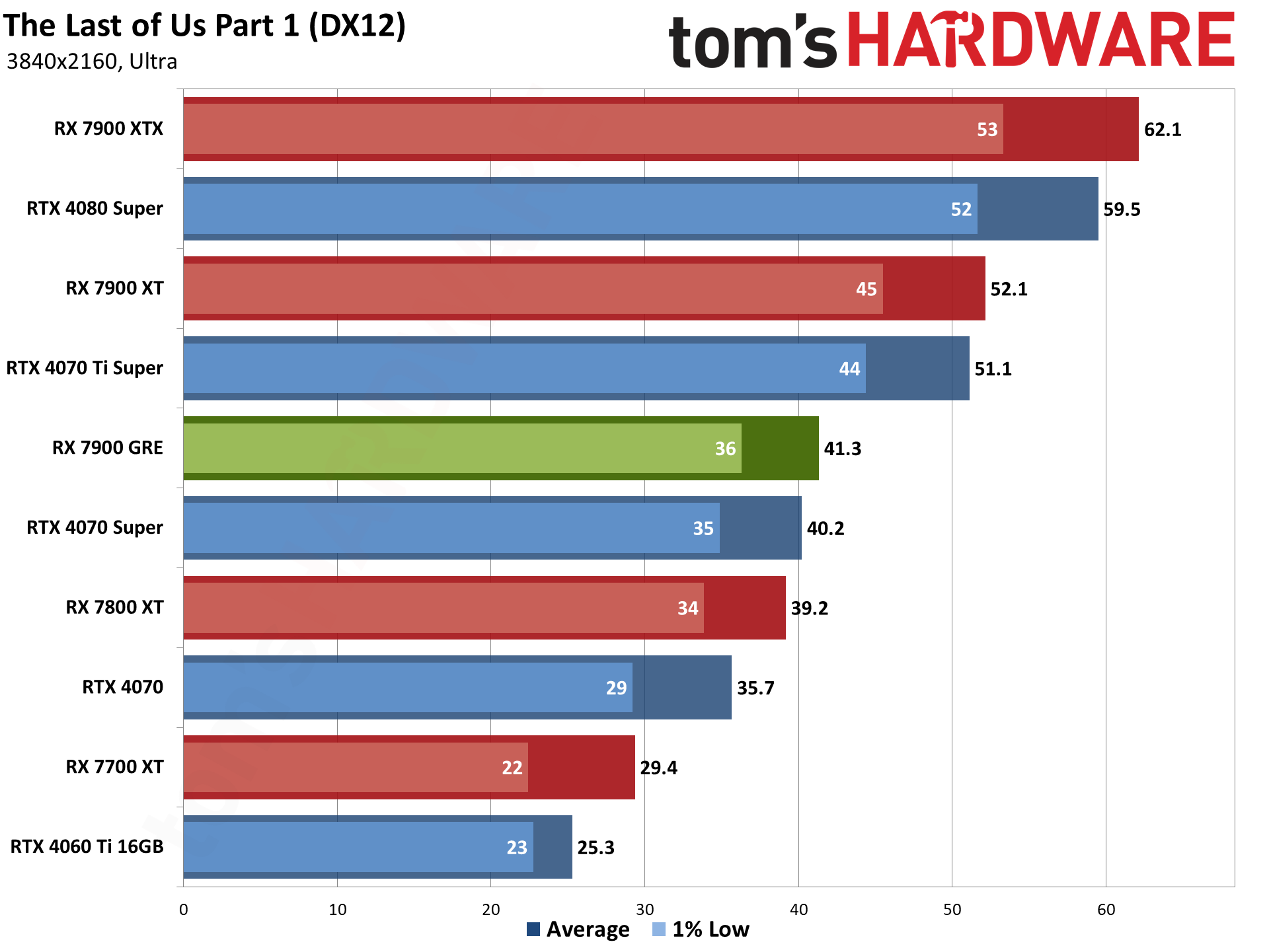
1440p was already a bit of a joke for AMD's GPUs in Alan Wake 2, and 4K isn't even remotely within reach. 4K with 2X upscaling results in single digit performance on the 7900 XT and below, with the 7900 XTX at 12 fps. Nvidia's RTX 4070 isn't playable either, but it does more than double the 7900 GRE performance here.
Things get substantially better in games that don't use path tracing, naturally. Assassin's Creed Mirage runs at a comfortable 69 fps on the 7900 GRE. Curiously, that's just a tad slower than the 7800 XT, which manages 70 fps. The RTX 4070 is also effectively tied with the GRE, with only a 1% difference in performance.
The 7900 GRE also claims a very small lead over the RTX 4070 in Avatar, but they're basically tied in performance. Against the 7800 XT, however, the GRE gets one of its larger wins, leading by 12%.
And The Last of Us continues to strongly favor AMD GPUs, with the GRE beating the RTX 4070 by 16%. It's only slightly faster than the 7800 XT again, with a 6% lead.
- MORE: Best Graphics Cards
- MORE: GPU Benchmarks and Hierarchy
- MORE: All Graphics Content
Get Tom's Hardware's best news and in-depth reviews, straight to your inbox.
Current page: AMD RX 7900 GRE: 4K Gaming Performance
Prev Page AMD RX 7900 GRE: 1080p Gaming Performance Next Page AMD RX 7900 GRE: Professional Content Creation and AI Performance
Jarred Walton is a senior editor at Tom's Hardware focusing on everything GPU. He has been working as a tech journalist since 2004, writing for AnandTech, Maximum PC, and PC Gamer. From the first S3 Virge '3D decelerators' to today's GPUs, Jarred keeps up with all the latest graphics trends and is the one to ask about game performance.
-
Notton So it falls directly between a 7800XT and 7900XT, and should have been called the 7900.Reply
It looks really good as a 1440p card.
It's not that interesting, considering it's price tag.
I'll wait to see what the RTX 5000 and RX 8000 series brings to the table, unless my 1070Ti croaks first. -
Giroro I'm surprised they didn't completely rebrand the card for the west. More generally, I'm surprised they're releasing it in the west at all.Reply
10% more performance for 10% more money isn't exciting, it's pointless. If they feel the need to release a minor stop-gap card, then I think they won't be ready to release anything truly exciting anytime soon. Maybe the AI surge has made them go back to the drawing board with RDNA 4.
It's hard to explain, but In my mind, something about calling it "Golden Rabbit" severely devalues it. So I imagine they at least will never spell out that acronym. Gold isn't valuable or aspirational; it's always cheap, fake, and tacky.
Also, I don't associate rabbits with being fast - I associate them with the weak fluffy bunnies that keep tearing up my yard.
Calling it golden means its a knockoff. It makes me think the GPU is actually some ancient Radeon HD 7970 chip that somebody is fraudulently trying to pass off as a counterfeit RX 7900 on Temu for $80 - or that it might have a virus or set my computer on fire.
Maybe I just buy too much counterfeit garbage from overseas. -
UnforcedERROR The conversation at $550 right now is almost specifically 1440p raster, which the 7900 GRE performs handily in. At these prices, 16 GB vs 12 GB for the 4070 is the biggest argument in its favor. Neither card is competent in Ray Tracing at 1440p, and the price-to-performance difference isn't enough to argue much otherwise, so it's mostly about longevity.Reply
As others said, it's not terribly interesting, and it feels like a notably late arrival, but it's something I suppose. I still feel like the $500 - $700 segment of cards is wholly disappointing from both NVidia and AMD. -
ohio_buckeye So it’s basically similar performance to a 6900xt or a 6950xt it sounds like? I’m happy with my 6800xt for now that I got under $450 new. I’ll hold onto that a while.Reply -
AgentBirdnest Hmm... I don't find it particularly exciting, but I don't have anything to complain about either. AMD had to do something to counter Nvidia's 4070 Super (and non-Super price drop), and this does it.Reply
What I'm really excited about, is where the 7800XT goes from here. I don't imagine it's going to stay at $500. If it drops to $450, that would be an extremely compelling option, and probably the best value of this generation.
As always, props to Jarred for the fabulous review! : ) -
thestryker Seems like decent enough perf/$, but doesn't really bring anything new to the table as expected. Not needing a video card has been a great place to be this generation as we're just now seeing some decent values though still limited to >$400.Reply
Per TPU the VRAM is limited to 2316mhz which caps the potential memory bandwidth at ~593 GB/s. The power limits on the card are at least standard so if anyone wants to try their hand at getting higher boost clock it is possible. -
ingtar33 this is basically just going to fill in the hole the 6900xt left in the market when it's stock ran out, they are both priced about the same, both perform about the same.Reply
It's not bad. the performance difference from the 7800xt to the 7900xt was pretty big (as was the $$ difference), this will slide right in between them at the old 6900xt price. It's a solid buy i think. I mean as solid as today's prices get.
everything is still overpriced. -
JarredWaltonGPU Reply
I do wish AMD hadn't lowered the VRAM speed from 20 Gbps. That probably would have given it another ~5% in performance, which would have been good. Right now, it's between the 7800 XT and 7900 XT, but slightly closer to the former. It makes sense from a pricing perspective, but even a few percent more overall performance would have been nice.ingtar33 said:this is basically just going to fill in the hole the 6900xt left in the market when it's stock ran out, they are both priced about the same, both perform about the same.
It's not bad. the performance difference from the 7800xt to the 7900xt was pretty big (as was the $$ difference), this will slide right in between them at the old 6900xt price. It's a solid buy i think. I mean as solid as today's prices get.
everything is still overpriced. -
Alvar "Miles" Udell Like all AMD cards for the last couple of generations, it's good, but it's just priced way too close to nVidia to be a true competitor, and this is no exception. At 2560x1440 and 3840x2160 the 4070 Super was effectively equal in terms of rasterization and superior with ray tracing, and it's only as little as $50 more expensive. How is AMD going to persuade all of the lifelong nVidia users and people like me who have had multiple negative experiences with Radeon cards to jump from Team Green over $50?Reply
And once third party custom models are included that price will exceed the 4070 Super, making the 7900 GRE a non starter. -
ohio_buckeye Reply
The good time to buy will be sales maybe around Black Friday imo. Now granted my 6800xt was last generation when I bought it this past December. On the other hand, $439 was a deal for a card that is essentially equivalent to a 7800xt.Alvar Miles Udell said:Like all AMD cards for the last couple of generations, it's good, but it's just priced way too close to nVidia to be a true competitor, and this is no exception. At 2560x1440 and 3840x2160 the 4070 Super was effectively equal in terms of rasterization and superior with ray tracing, and it's only as little as $50 more expensive. How is AMD going to persuade all of the lifelong nVidia users and people like me who have had multiple negative experiences with Radeon cards to jump from Team Green over $50?
And once third party custom models are included that price will exceed the 4070 Super, making the 7900 GRE a non starter.
As someone above said if they’d put the 7800xt at $450, or even $475 then it goes on sale, that would be a decent price to performance imo.
